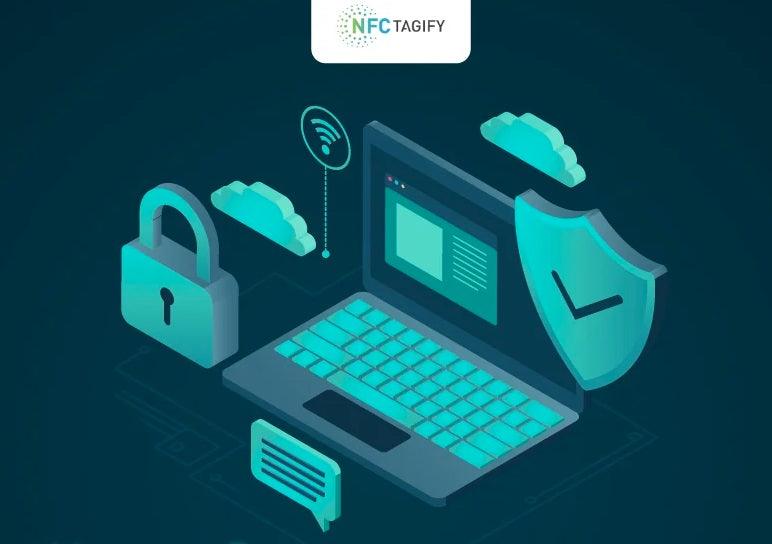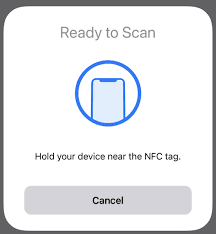How to Secure NFC Business Cards? - Infographic

Contents
- 1- What is NFC?
- 2- Security Issues of the NFC Technology
- 3- Ways to Secure Digital Business Cards
- 4- ● Only Use Trusted Platforms
- 5- ● Always Update Your Profile
- 6- ● Store Digital Cards in a Safe Place
- 7- ● Be Careful about Using Your Card
- 8- ● Report Any Suspicious Activity
- 9- Know More About Digital Business Cards with NFC Tagify

What is NFC?
One prime example of continuous technological improvement is NFC or Near-Field Communication. NFC is one of the technologies that power contactless business cards. This allows the users to make secure transactions, exchange digital content, and connect electronic devices by being just a short distance away. Similar to Bluetooth technology, NFC is a language electronic device. Both technologies rely on radio waves to pass information. But these two have stark differences, such as power. On this aspect, NFC is the more convenient choice as it does not need a power source to function. On the other hand, speed is Bluetooth’s strength, as it can transmit data at about 1MB per second. NFC can only share a maximum of 424KB per second. The good thing about NFC technology is that it can be utilised by private individuals and businesses alike. In consumer devices, Google added NFC support in its Kitkat OS release. Meanwhile, Apple has been supporting this technology since the iOS11 update. Users with such devices can enjoy NFC’s tap-to-pay capabilities. For enterprises, NFC is typically used in smart cards for access control to office buildings and secured doors. People in the business world may also use this technology as a business card or Customised NFC Card, where they can put all their necessary information for easier dissemination. However, like other technological innovations, NFC may also have some issues, especially in security.
Security Issues of the NFC Technology
NFC has been around for quite some time, and its usage has grown over recent years. When it was first introduced, its purpose was to transfer files between phones using Android Beam. But as time went on, near-field communication technology evolved and is now integrated into contactless payment, identity verification, or business cards. This growth only shows how technology is constantly evolving. But while NFC is undeniably useful, there are some threats users might want to look out for.
● Eavesdropping
Eavesdropping refers to the act of secretly listening to the private conversations of others without their consent. In NFC, eavesdropping happens when a criminal “listens” in on an NFC transaction. The hacker does not need to pick up every signal to gather information. Users must understand that although NFC’s range is limited to a few centimetres, the possibility of criminals retrieving usable signals is never zero.
● Data Corruption and Manipulation
Another security threat for NFC is data corruption and manipulation. This happens when a criminal manipulates or interferes with the data being sent, making it corrupted and useless once it arrives. For this threat to be prevented, users must secure channels that are used for communications.
● Interception Attacks
An interception attack is an NFC security threat somewhat similar to data manipulation. It occurs when a person acts as a middleman between two NFC devices. Once the information reaches the “middle man,” they will alter and intercept it. NFC users must be more vigilant with this attack as it is way more complex and less common than other security risks. This can be prevented by utilising an active-passive pairing. This means only one device receives the information while the other sends it.
● Theft
One of the hardest NFC security threats is theft. No amount of encryption can protect a consumer once their phone is stolen. If a user is robbed of their smartphone, the thief can quickly go through their mobile device and meddle with the user’s accounts. Criminals may also wave the stolen phone over a store card reader and make a purchase. Avoiding this from happening would depend on the owner of the phone. Smartphone owners must be diligent in securing their phones by installing passwords or other locks. But the safest way to prevent this is never to leave your phone unattended, especially in a public area.
Ways to Secure Digital Business Cards
Users may think that NFC would only open up a world full of new online safety threats. But what many people need to realise is that NFC is still relatively safer than its predecessors. Take digital business cards as an example. Unlike printing business cards, digital ones can be distributed online. And many could be hesitant about putting their information online as it is no secret how risky the internet is when it comes to data. That said, here are some tips to secure digital business cards.
● Only Use Trusted Platforms
While this should be a common practice, many still fall victim to using free providers that are usually unsafe. To keep your digital business card safe, only trust platforms the industry has vetted for their strong reputation. This will keep you at ease since trusted providers are most likely to have the latest and strongest security measure in protecting digital business cards.
● Always Update Your Profile
Another way to keep your data secure is by updating it. Make sure that the information included in the NFC card is up-to-date. For example, if there are any changes in your contact details (number, email address, social media links, websites, etc.), make sure that these alterations will be reflected in the card.
● Store Digital Cards in a Safe Place
Similar to smartphones, digital business cards should be stored in a safe place where they would not be easily lost or stolen. One good option is to keep the card in a protective sleeve. This will also help in ensuring that the card is within reach. Other options include purchasing NFC protection wallets. These wallets are specifically designed to protect NFC cards as they have a layer that encrypts the NFC signal. This helps keep the stored information safe in case of being lost or stolen.
● Be Careful about Using Your Card
One of the easiest ways to protect digital business cards is to choose the ones you will share them with. Make sure you only exchange digital business cards with the people you have met. If you need to give information to someone you do not know well, it would be best to stick with the traditional ones. You may also have a tracking system that will allow you to monitor who are the people you are giving out your cards.
● Report Any Suspicious Activity
Like other technology, the first thing you should do when your NFC card is lost or stolen is to report it to the card provider. This way, they can deactivate the card so unauthorised people will not be able to use it. Furthermore, they may be able to provide you with a new card with better and updated security measures.








